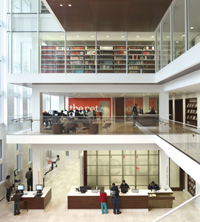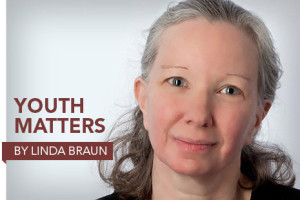
Libraries are all about people—both the people who use their services and the people who work there. Some key areas of concern for libraries relate to patrons with disabilities and patrons who use the library as their primary access point for technology. Library staff members need to know what technology barriers patrons may face and how staff members can be open to overcoming them.
Assistive and adaptive technology makes the library and its resources work for users with disabilities. The terms assistive and adaptive are applied to aids that either assist the user in accessing a library resource or adapt that resource in such a way that it becomes usable. Many of these technologies are aimed at adapting computer-based resources (e.g., screen magnification software, trackball controllers), but several technologies are available for helping with more traditional library sources (e.g., teletypewriters, recorded books). A careful assessment of the needs of those with disabilities in the community can help a library staff decide which of the following technologies are required. This assessment and the added technologies can help the library meet the requirements of the Americans with Disabilities Act (ADA). More important, it can ensure that the library is meeting its mission by providing all of its users with the information they need.
Technology for public computers
A standard library computer is not usable by patrons with certain disabilities, such as blindness or limited motor ability. Many technological products are available to make computers easier to use for those with disabilities:
- Screen-magnifying software. Software that magnifies the text and images on a computer’s monitor is extremely helpful to patrons with low vision. It allows users to control the level of magnification on the screen to fit their specific requirements. These programs offer several options for controlling the area of the screen that is to be magnified at any one time. For example, users can magnify the entire screen at once and scroll through all of the enlarged web page or document using the mouse. Users may also choose to magnify a defined area of the screen, and they can maneuver a box-like frame around the screen to center on a specific section to magnify. Many other settings and options are available.
- Screen-reading software. For those with extremely low or no vision, screen-reading software can extend and improve the accessibility of any material that can be displayed on a computer monitor. The software reads aloud whatever text appears on the monitor, whether it is the library catalog or another resource. Patrons can use different voices, adjust the speed of the reader, and train the reader to skip certain unreadable characters or improve its pronunciation of other words. Of course, anytime a sound-producing device or software appears in a library, there is a need for headphones to accompany the software.
- Touchpad or trackball controllers. Patrons who are unable to use a standard mouse (such as those with developmental disabilities or carpal tunnel injuries) can use trackballs and touchpads that exert less pressure on their hands, wrists, and arms. Rotating a trackball with one’s palm removes the need to grip a controller with the whole hand. Touchpads allow users to control a mouse by moving an index finger along a pad that corresponds with the layout of the monitor screen.
- On-screen keyboard. Patrons who cannot enter text using a traditional keyboard may be able to use an on-screen keyboard via software that allows a keyboard to appear on the screen. A user can then click the board using a mouse to select—in other words, type—letters that will appear in a web browser or other application.
Technologies for other services and materials
There are also technologies that can make noncomputer resources and library services easier to use:
- Teletypewriter. For patrons who have difficulty hearing, a teletypewriter (TTY) connection offers a means for communicating with library staff members. A TTY device is connected to a telephone at a patron’s home and to a telephone at the library so messages can travel back and forth. Some libraries set up a separate line for this service. This can be extremely helpful for obtaining library information, asking and answering reference questions, and making other requests of library staff. Some libraries are finding that virtual reference through web-based chat or instant messaging can be an effective replacement for standard TTY devices.
- Closed-captioning. DVD/video equipment should include the option of closed-captioning so that users with hearing difficulties can still make use of videos. Most televisions or television/DVD/VCR combinations include this as an option.
- Magnifiers. Book and periodical magnifiers can make traditional library materials more usable for patrons with low vision. These units have a tray on which one can place a print publication. Over the tray is a magnifier unit that displays the publication on a screen. As with the computer screen magnifier, setting adjustments are available. Another version of this technology is closed-circuit television, in which the magnifier is hooked up to a television of any size for ease in viewing.
- Audiobooks. For patrons with extremely low or no vision, recorded books in various storage formats should be made available. Wonderful work is being done by dedicated talking-book libraries throughout the world. This particular medium is an easy one to add to any library’s collection. Many titles are available as audio ebooks in addition to earlier audio formats (e.g., compact discs).
- Kurzweil readers. The Kurzweil reader in its many varieties has had an immeasurable impact on making printed materials available to individuals with no vision. This device scans and audibly reads the information printed on a page.
- Braille equipment. Braille translators and printers may also be of use to those patrons who prefer having Braille copies of printed materials. These devices require a computer set up with translating software and an accompanying printer that prints Braille characters on paper. The equipment can be quite expensive, but not many libraries need such a device.
Web and interface design considerations
When designing a library website or database, remember individuals with extremely low vision or no vision who are accessing these electronic resources using screen-reader software.
A number of items (such as images) are completely ignored by this reading software. Typically, people who use screen-reading software are also using a simplified, nongraphical web browser. Web designers should review how their pages display in text-based browsers such as Lynx. Images will not display, but in the HTML (hypertext markup language) coding used to make web pages there are image tags that will appear as captions. Designers should make sure all images have image tags. Section 508 of the Rehabilitation Act (section508.gov) provides standards on web design that are now required of all US federal agencies. Other community and public institutions (such as libraries) are following these site design standards as well. The World Wide Web Consortium (W3C), a web standards organization, has a page on its Web Accessibility Initiative that can help with accessibility questions (w3.org/WAI).
Libraries must rise to the challenge and accommodate the needs of patrons who depend on them for technology access and assistance. This need calls for resources that libraries do not always have in abundance and for policy changes that may take time to work out to the satisfaction of patrons and staff. Libraries must make the case to their funding agencies that they are not just the “people’s university” of old but also the “people’s technology lifeline.” This means more than just offering internet access; it may mean offering word processing for job applications or assistance in navigating the websites of government agencies. No matter their size or equipment, libraries stand as beacons and sources of hope to those who need access to technology.
JOHN J. BURKE is the library director at Miami University’s Middletown, Ohio, regional campus and the author of the Neal-Schuman Library Technology Companion and (with Beth Tumbleson) Embedding Librarianship in Learning Management Systems (ALA Neal-Schuman). This is an excerpt from Neal-Schuman’s Library Technology Companion, A Basic Guide for Library Staff, 4th edition.


